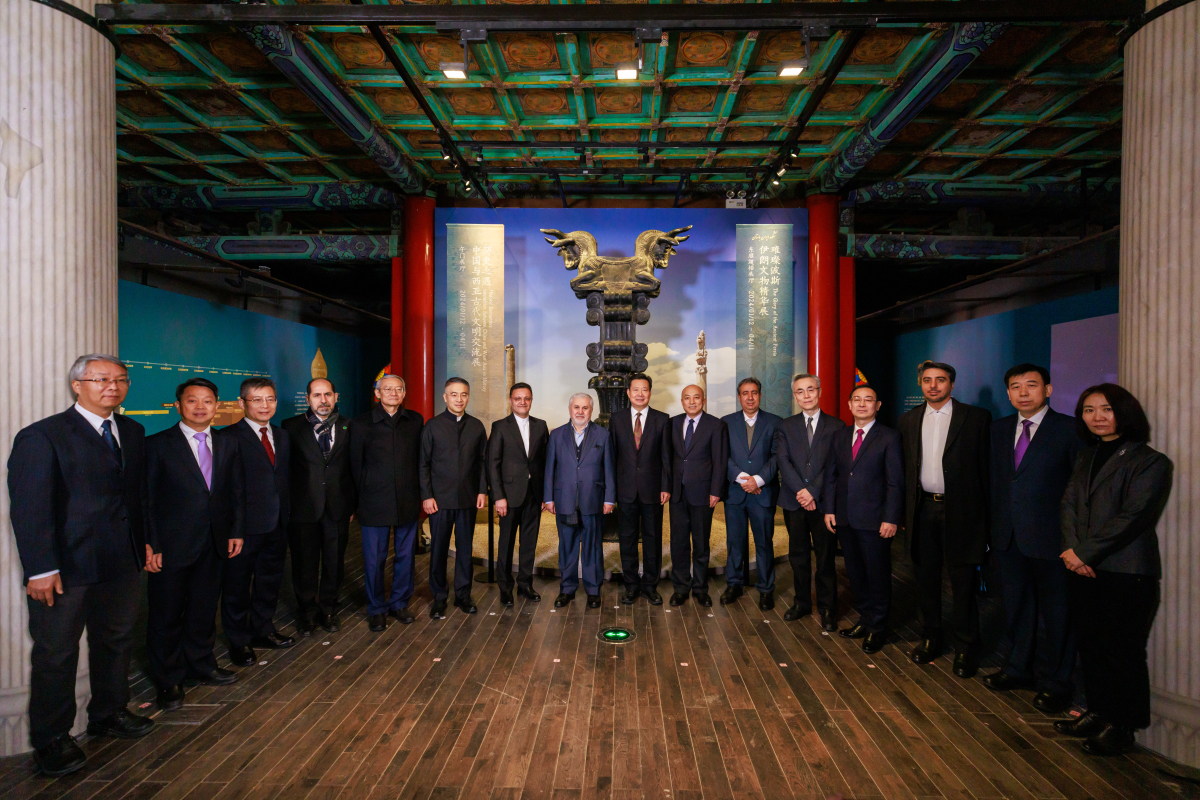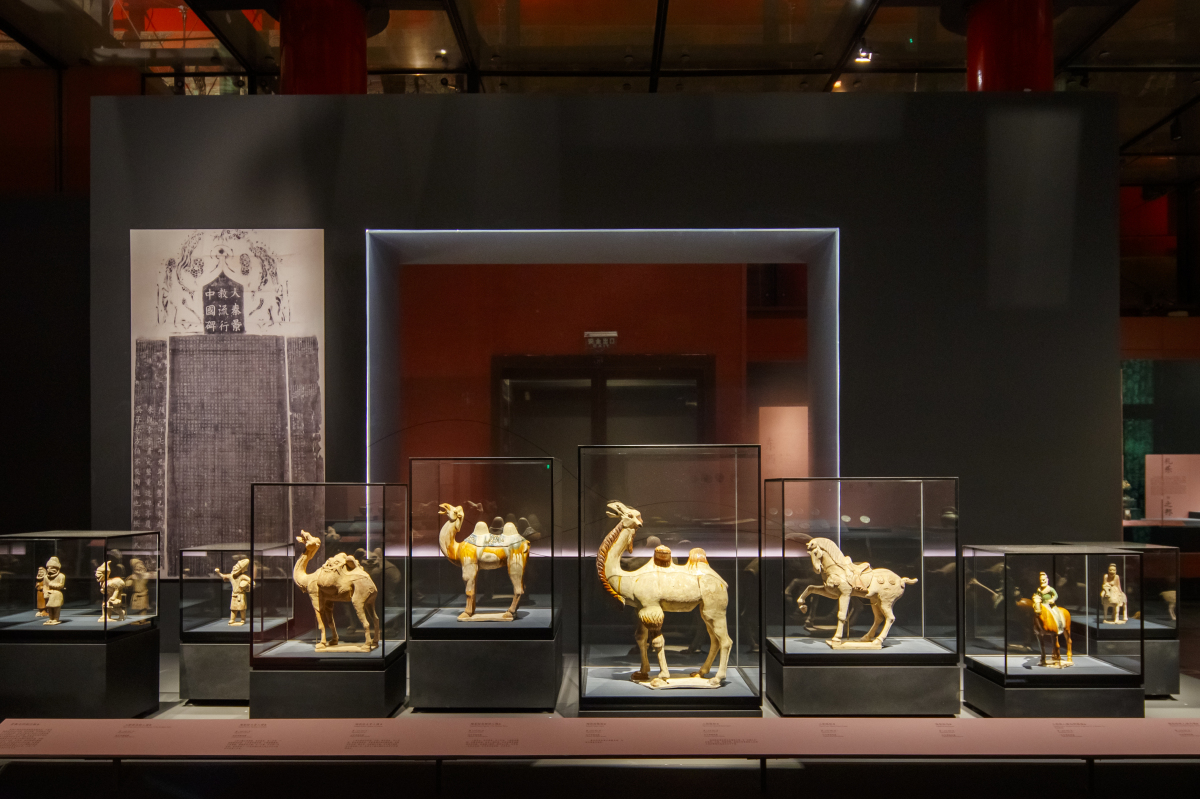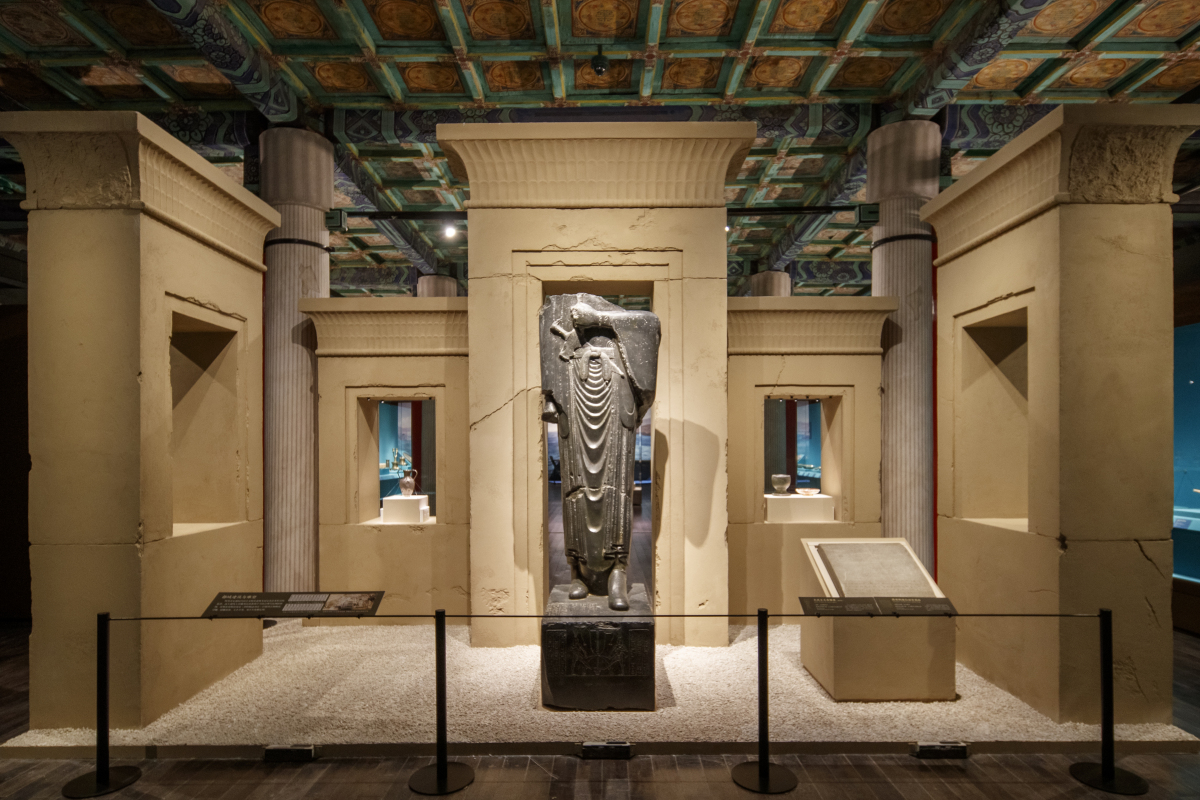The joint opening ceremony of the two exhibitions, “Historic Encounters: Interaction Between China and West Asia in History” and “The Glory of the Ancient Persia”, was held at the exhibition hall of the Meridian Gate (Wu men) on January 11, 2024.
Li Qun, vice minister of culture and tourism and director of the National Cultural Heritage Administration; Wang Xudong, director of the Palace Museum; Ali Darabi, deputy of cultural heritage in the Ministry of Cultural Heritage, Tourism and Handicrafts; Mohsen Bakhtiar, Iranian Ambassador to China; Jebrael Nokandeh, director general of the National Museum of Iran; and Gu Shu, chairman of the Agricultural Bank of China, attended the opening ceremony and delivered speeches. The event also saw the presence of Wang Xiaozhen, vice president of China Media Group (CMG); Zhang Ming, secretary-general of the Shanghai Cooperation Organization; Xin Qi, special advisor to the International Confucian Association; Ambassador Lyu Jian from the Department of West Asian and North African Affairs at the Ministry of Foreign Affairs; Chen Xingcan, deputy director of the History Research of China and director of the Institute of Archaeology of the Chinese Academy of Social Sciences; as well as ambassadors or embassy representatives from Afghanistan, Iraq, Kuwait, Oman, Tajikistan, Syria, India, and other countries. Representatives from major domestic cultural and heritage institutions and leading experts in West Asian culture and art were also in attendance. Lou Wei, deputy director of the Palace Museum, presided over the opening ceremony.
The Palace Museum is a monumental representation of 5,000 years of Chinese civilization. It serves as a focal point for the aggregation and celebration of traditional Chinese culture and acts as testament to the rich tapestry of multicultural exchanges and integration. The museum is dedicated to utilizing cultural relics and related materials to not only display the essence of traditional Chinese culture but also foster cultural exchanges and position itself as a global platform for civilizational dialogue. Over the years, the museum has actively promoted cultural outreach globally through various exhibitions, narrating China’s story to the international community, offering access to China’s long history and splendid culture, and showcasing the unique charm of Chinese civilization. It has also introduced numerous high-quality exhibitions from around the world to share cultural achievements of humanity and promote dialogue and interaction among civilizations.
Based on deep academic foundations and long-term exchanges with domestic and international counterparts, since 2019, the Palace Museum has cooperated with institutions such as the National Museum of Iran, the Ministry of Cultural Heritage, Tourism and Handicrafts of Iran, and the Royal Commission for Al Ula, Saudi Arabia. These partnerships have been instrumental in facilitating exhibitions that showcase understanding, exchange, mutual learning, and development, presenting “Historic Encounters: Interaction Between China and West Asia in History,” “The Glory of Ancient Persia,” and "Al Ula, Wonder of Arabia" as three distinct yet interconnected exhibitions. Opened at the beginning of 2024 at the Meridian Gate exhibition hall, these exhibitions use exquisite cultural relics to connect significant civilizations along the Silk Road, showcasing the long and brilliant history of different cultures and long-standing exchanges, mutual learning and common development of civilizations in building a global community of shared future.
Li Qun noted in his opening address that these exhibitions provide a unique opportunity for Chinese audiences to deepen their understanding of ancient Persian civilization and experience firsthand the long-standing interactions and exchanges between Chinese and Iranian civilizations, bringing to life the significant “historic encounter” between these two great cultures.
He noted that Iran was one of the first countries to respond to the Asian Initiative for Cultural Heritage Conservation proposed by President Xi Jinping. He highlighted China’s readiness to collaborate with Iran and fellow members of the Asian Alliance for Cultural Heritage Conservation in advancing the Global Civilization Initiative. This commitment involves consistently reinforcing the Asian Alliance for Cultural Heritage Conservation and engaging in tangible cooperation across diverse cultural heritage domains. These include joint efforts in ancient civilization research, collaborative archaeology, heritage restoration, and reciprocal museum exchanges. Together, they aim to craft a new narrative that elevates the exchanges and mutual learning of human civilizations in Asia to unprecedented heights.
Ali Darabi emphasized the extensive history of cultural exchange between Iran and China, noting the significant role museums play in preserving and showcasing civilization, fostering peaceful development, and bringing countries closer together. Darabi highlighted Iran’s dedication not only to its own cultural heritage but also to the appreciation and understanding of other countries’ cultural heritage. The exhibition will help enhance cultural understanding between the two countries, promote the in-depth development of cultural heritage cooperation between Iran and China, and is an important step in strengthening cultural exchanges between the two countries, he said.
In his speech, Wang Xudong said the concurrent exhibitions of cultural relics from Iran, Saudi Arabia, and China at the Meridian Gate were possible thanks to substantial support from the governments of these three countries, as well as the collaborative efforts of their respective museums and archaeological institutions. Such cooperation, he said, was crucial to the implementation of the Global Civilization Initiative proposed by President Xi Jinping. The Palace Museum is eager to collaborate with both Chinese and international museums, as well as other institutions, to collectively delve into and exhibit the depth of human civilization and the contemporary values encapsulated in cultural relics. Wang further emphasized the goal to foster mutual understanding and respect among diverse cultures, making substantial contributions to the establishment of a global community of shared future.
Mohsen Bakhtiar reflected on the millennia-old friendly interactions between China and Iran, with cultural heritage exchange forming the basis of their multifaceted relations. The exhibition not only showcases Iran’s rich cultural heritage but also narrates the prosperity of ancient Iranian civilization. He also emphasized the role of cultural heritage exchanges in furthering mutual understanding and friendship between the people of the two nations.
Jebrael Nokandeh highlighted Iran’s ancient history and important location among ancient civilizations, which fostered continuous interaction and integration with surrounding cultures, leading to a civilization of distinctness and brilliance. The exhibition, featuring 216 exquisite artifacts, displays the beauty of Iranian art and explores the path of intertwined civilization development. He also revealed that the National Museum of Iran will deepen exhibition cooperation with the Palace Museum, including hosting exhibitions in Iran that showcase Chinese civilization.
Gu Shu said that the Agricultural Bank of China had supported numerous cultural relic protection and utilization projects in recent years. Since signing a strategic cooperation agreement with the Palace Museum in 2017, it has supported several major exhibitions. He noted that the bank will implement the national strategy of building strength in culture, and support the creative transformation and innovative development of excellent traditional Chinese culture.

“Historic Encounters: Interaction Between China and West Asia”
The “Historic Encounters: Interaction Between China and West Asia” exhibition opened at the Meridian Gate (Wu men) main hall on January 12 and will run through April 11, 2024.
Situated at opposite ends of the Asian continent, China and West Asia have long-standing ties dating back to ancient times. From the prehistoric era, the exchanges of agricultural, pastoral, and handicraft practices, as well as mutual learning in arts and culture, have been documented in historical records and integrated into daily life. Together, these ancient civilizations contributed to the glory of the Silk Road, fostering shared prosperity across the Eurasian continent.
The exhibition is divided into two sections: “Reflections of the East and West” and “The Great Road That Connects.” The “Reflections of the East and West” section brings to life the historical encounters and friendship between China and West Asia. Through a range of documents and artifacts, this section portrays the origins of Chinese civilization and its fundamental philosophy emphasizing that “the order and harmony of heaven and earth are echoed in rites and music.” It unveils the early chapters of exchanges between civilizations. “The Great Road That Connects” is segmented into six parts themed on envoys, metallurgy, glass, silk, furniture, and blue-and-white porcelain, respectively. This section showcases the interplay and mutual inspiration in technology, art, culture, and philosophy between the ancient civilizations of China and West Asia. It also narrates the story of China along the Silk Road, emphasizing the inclusive and innovative characteristics of Chinese culture.

The exhibition, grounded on the collections of the Palace Museum, brings together a total of 266 items (or sets) of cultural relics from 10 archaeological and cultural institutions from both home and abroad. These include Datong Museum, the Cultural Relics and Archaeology Institute of Inner Mongolia Autonomous Region, the Ethnic Costume Museum of Beijing Institute of Fashion Technology, Dongguan Museum, Hepu Museum, Famen Temple Museum, Zhengzhou Municipal Institute of Cultural Heritage and Archaeology, Nanyue King Museum, Xinjiang Uygur Autonomous Region Museum, and the National Museum of Iran.
The artifacts span a vast timeline, from the Neolithic era to the Ming (1368-1644) and Qing (1644-1911) dynasties, ranging from bronze, gold, silver, jade, and glass wares to ceramics, textiles, furniture, and sculptures. Among the standout pieces are a boar tusk carving of a silkworm, a cultural relic of the Yangshao culture unearthed at the Shuanghuaishu site in Zhengzhou; a Western Han (202 BC-8 AD) silver box unearthed from the tomb of the Nanyue King in Guangdong; a Tang dynasty (618-907) blue glass plate with intricate carvings from the Famen Temple crypt in Shaanxi; a Tang dynasty brocade with knight imagery from the Astana Cemetery in Turpan; a Shang dynasty (c. 1600-1046 BC) bronze dragon-head knife from the Palace Museum’s collection; a Qing dynasty Qianlong-era red lacquer basin adorned with jade and grape bonsai; and a blue and white porcelain celestial globe vase featuring sea water and white dragon patterns from the National Museum of Iran.
“The Glory of Ancient Persia”

The exhibition “The Glory of Ancient Persia,” co-organized by the Palace Museum, the Iranian Ministry of Cultural Heritage, Tourism and Handicrafts, and the National Museum of Iran, opened at the East Wing Gallery of the Meridian Gate (Wu men) on January 12, and will run through April 11, 2024.
Iran, situated in West Asia, is home to an ancient and profound civilization, with its roots extending back to hundreds of thousands of years ago. The country has seen the rise and fall of influential dynasties such as the Achaemenid, Parthian, and Sassanian, each leaving a significant imprint on the world stage. In Chinese historical records, Iran was known as “Anxi” during the Western Han period and later as “Persia”. Standing at the pivotal junction of the East and the West, Iranian art integrates cultural elements from diverse ethnic groups, achieving remarkable accomplishments that have influenced many countries and regions across Eurasia.
The exhibition consists of two sections – “Beauty of Inclusiveness” and “East-West Communication,” and features 216 artifacts from multiple Iranian museums. It spans a wide array of items, from palace architecture and household furniture to precious treasures and everyday utensils, as well as ancient paintings and scripts. By presenting a diverse array of artifacts, including architecture, sculpture, ceramics, glass, metal, calligraphy, and painting, the exhibition captures the enduring charm of ancient Iranian art, providing a window into the splendid and rich cultural heritage of ancient Persia, which was shaped by cultural exchange and mutual learning.
“Al Ula, Wonder of Arabia”
The exhibition “Al Ula, Wonder of Arabia” is co-organized by the Royal Commission for Al Ula and the Palace Museum, with support from the French Agency for Al Ula Development. It opened at the West Wing of the Tower Gallery, Meridian Gate (Wu men) on January 6, and will run through March 22, 2024.
Al Ula, a valley oasis in the Saudi Arabian desert, has been a cradle of human civilization for over 7,000 years. The area boasts a wealth of archaeological sites, of which the most renowned is Hegra, Saudi Arabia’s first site to be recognized as a UNESCO World Heritage site. The exhibition is divided into four sections: “From Prehistoric Period to the Bronze Age,” “Northern Arabian Kingdoms,” “Script and Language,” and “Modern Al Ula,” illustrating how humans have adapted to and transformed this harsh environment to create wonders. The exhibition offers a unique, immersive opportunity to explore Saudi Arabian culture, showcasing Al Ula’s breathtaking natural landscapes, rare archaeological findings, and rich cultural heritage.
These exhibitions, “Historic Encounters: Interaction Between China and West Asia in History” and “The Glory of Ancient Persia,” are promoted by the Agricultural Bank of China under the mission of “Building a Beautiful China for a Shared Happy Life.” The Agricultural Bank of China, a leading financial service provider in China, remains committed to enhancing national cultural strength. It actively integrates finance with culture, supporting the innovative development and creative transformation of fine traditional Chinese culture through its financial expertise.
Media Interview:
Exploring Civilizational Development Through Exchanges and Mutual Learning
(Wang Guangyao, chief curator and researcher at the Palace Museum)
Throughout history, people from various regions have traversed mountains and sailed across seas, enduring great hardships to interact with distant worlds. Their relentless quest for new knowledge and better resources from beyond national borders to enhance the quality of their lives and develop a stronger sense of self, has been a continuous thread in history. These efforts have been woven into the fabric of history. At the same time, the exchanges have shaped the vast network of communication channels connecting Asia, Africa, and Europe, known today as the Silk Road. These interactions form the tapestry of world history and, along with archaeological findings, provide the basis for studying the ancient world and understanding our early interactions.
Archaeological studies and research on the Silk Road confirm that East-West exchanges, the main routes of travel, and participation in larger networks of exchange directly influenced the rise and fall of ancient states along these routes. Therefore, it is clear that long-term and extensive exchanges have propelled the development and progress of different nations and ethnicities worldwide, advancing global civilization.
This exhibition, focusing on the interactions between China and West Asia, is grounded on two key considerations. Firstly, West Asia has been one of the primary regions for China's external exchanges throughout history. Over extended periods, the civilizations of the East, represented by China, and those of West Asia, symbolized by Persia and Arabia, have been brilliant beacons of human civilization on the Asian continent. In a sense, Chinese and West Asian civilizations have shone together. Their interactions and mutual influences have not only benefited each other but have also catalyzed the development of surrounding ancient nations and ethnic groups.
Secondly, the exhibition reflects on the factors contributing to the emergence of major world civilizations over thousands of years. Why did civilization centers emerge in China, the Indus River Valley, along the Mediterranean in West Asia, and at the intersection of South and North America? It’s because these regions were hubs of human exchange and convergence of multiple cultures. In the Tang dynasty, Kong Yingda’s commentary on the Book of Documents defined “civilization” (“wen ming” in Chinese) like this: “To weave the heaven and the earth is called ‘wen’ (culture or pattern); to shine upon and illuminate the four corners of the world is called ‘ming’ (brightness or enlightenment).” Civilization encapsulates the idea of driving collective progress while pursuing self-development, reflecting an aspiration for shared harmony and prosperity. Therefore, the influence and cohesiveness of a civilization are mostly correlated. This relationship is built on a foundation of openness and inclusiveness and shaped by the scope and depth of its external interactions, as well as the diversity of the regions and ethnic groups it connects with. At its core, it is centered around the ability to engage in exchanges and embrace inclusivity.



